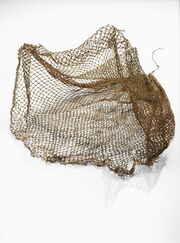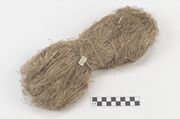Nettle
Description
Generally a name for plants with stinging hairs, but specifically refers to plants from the family Urticaceae. Nettles have been cultivated for centuries in Europe and Asia as a source of fiber for ropes and sails. The best known fibers from th Urtica family are Stinging nettle (Urtica dioica), small nettle (Urtica urens), Giant nettle (Urtica ardens), and the Roman nettle (Urtica pilulifera). https://cameo.mfa.org/wiki/Category:FRIL:_Stinging_NettleThey are used for twine, rope, canvas and sailcloth. Nettle fibers are also used as substitutes for flax and hemp.
Ramie (Boehmeria nivea) is also in the nettle family.
For nettle fiber identification, see http://cameo.mfa.org/wiki/Category:FRIL:_Plant_Fibers. Pages are available for:
Synonyms and Related Terms
brandnetel (Ned.); ortie (Fr.) Nessel (Deut.); ortica (It.); ortiga (Esp.)
Physical and Chemical Properties
- Urtica dioica: fiber has small diameter and thick cell wall; similar to linen
- Urtica urens: fiber has larger diameter with thin cell wall
Resources and Citations
- Wikipedia: Urtica (accessed July 2023)
- G.Cook, Handbook of Textile Fibres:I. Natural Fibres, 5th edition, Merrow Publishing Co., Durham, England, 1984.
- R.King, E.Hartley, "Unusual Fibers Used in Northwest Coast Ethnographic Textiles, Their Preparation & Their Structure", Technology & Conservation, 1/79.
- Henry Hodges, Artifacts: An Introduction to Early Materials and Technology, Ronald P. Frye, Kingston, Canada, 1988
- A.Lucas, J.R.Harris, Ancient Egyptian Materials and Industries, Edward Arnold Publishers Ltd., London, 4th edition, 1962
- Fairchild's Dictionary of Textiles, Phyllis G.Tortora, Robert S. Merkel (eds.), Fairchild Publications, New York City, 7th edition, 1996
- Website: For translations: www.allwords.com

